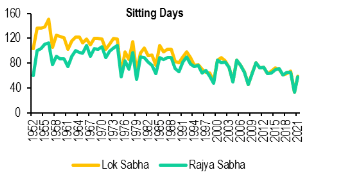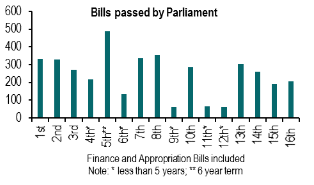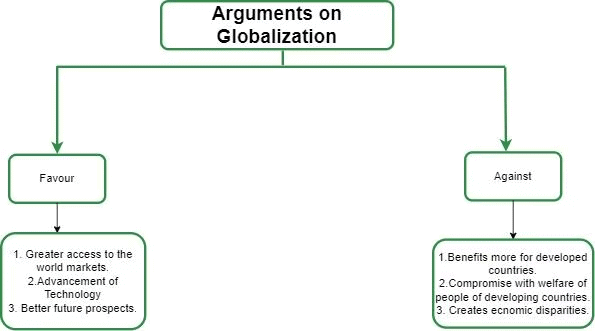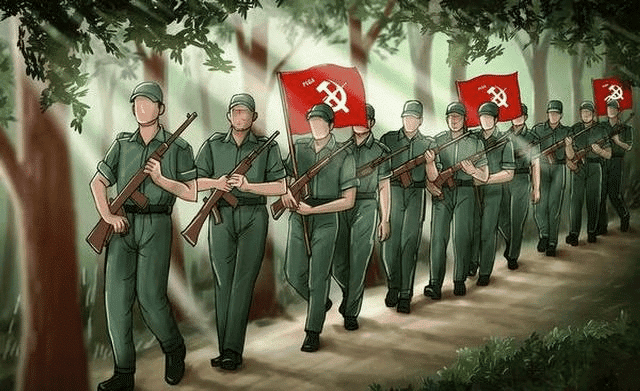Weekly Current Affairs (15th to 21st December 2024) Part - 1 | Current Affairs & Hindu Analysis: Daily, Weekly & Monthly - UPSC PDF Download
Enhancing Parliamentary Productivity


Why in News?
- Recently, the former Vice President of India expressed concerns over the increasing disruptions in Parliament. He emphasized the necessity for a shift from confrontational politics to constructive debates. He called on political parties to restore parliamentary decorum, encourage consensus, and prioritize meaningful dialogue to strengthen democracy and rebuild public trust.
Key Takeaways
- Disruptions waste time and undermine legislative functions.
- Political polarization hampers effective governance.
- Attendance and participation in debates are notably low.
- Quality of legislation suffers due to insufficient debate and scrutiny.
- Gender representation in Parliament remains low.
Additional Details
- Frequent Disruptions: These are often caused by opposition protests, leading to significant time wastage and undermining the legislative process. For example, during the 2023 Winter Session, 141 opposition MPs were suspended due to protests over breaches in parliamentary security.
- Political Polarization: The growing divide between government and opposition parties has fostered a culture of adversarial politics, which stalls legislative progress and hampers consensus-building.
- Low Participation Rates: In the 17th Lok Sabha (2019–2024), average attendance was 79%, but participation in debates was limited. For instance, attendance during the Budget Session of 2021 fell to 69% due to the pandemic.
- Poor Quality of Legislation: Legislative quality is often compromised as bills are passed hastily without adequate discussion, leading to issues like the Right to Information (Amendment) Bill, 2019, which faced criticism for insufficient stakeholder consultation.
- Lack of Gender Equality: In the 18th Lok Sabha, only 74 women were elected, representing 13.6% of its members, a slight decline from the previous Lok Sabha.
To address these challenges, several steps have been taken:
- Code of Conduct: A code of conduct was established to promote parliamentary decorum and discourage disruptions.
- Technology Adoption: Live streaming of parliamentary proceedings enhances accountability and encourages disciplined behavior among MPs.
- Committee System: This robust system allows for thorough scrutiny of bills and government initiatives before they reach the main House.
- Disciplinary Actions: MPs engaging in disruptive conduct face suspension or expulsion, ensuring accountability.
To improve the productivity of Parliament, several reforms can be implemented:
- Commitment to Constructive Debate: Political parties should prioritize constructive dialogue over obstructionist tactics to ensure productive discussions.
- Strengthening the Role of the Presiding Officer: Enhancing the powers of the Speaker/Chairman can help maintain decorum and facilitate smoother legislative processes.
- Promoting a Culture of Accountability: Monitoring MPs' participation can enhance accountability, supported by the Right to Information (RTI) Act for transparency.
- Public Engagement and Transparency: Increasing public awareness about parliamentary functions can rebuild trust in the institution.
- Youth Engagement in Politics: Encouraging young leaders to embrace integrity and transparency can introduce fresh perspectives into parliamentary proceedings.
In conclusion, the Indian Parliament faces significant challenges like frequent disruptions and low participation rates, which affect legislative effectiveness. However, reforms such as implementing a code of conduct, adopting technology, strengthening committee systems, and enforcing disciplinary measures are critical to addressing these issues. Focusing on transparency, accountability, and inclusivity will help Parliament effectively represent the people and create impactful legislation.
Question:
- What are the reasons behind frequent disruptions in Parliament? How can procedures be reformed to ensure uninterrupted debates?
India and the Changing Landscape of Globalisation
 Why in News?
Why in News?
- Recent geopolitical developments, including the ongoing conflict in Russia and Ukraine, unrest in the Middle East, and deteriorating relations between China and the West, have raised significant questions about the future of globalisation and its impact on countries such as India. Concurrently, India’s vision of Aatmanirbhar Bharat has sparked discussions on how to balance self-reliance with global integration.
Key Takeaways
- Globalisation refers to the increasing interconnectedness of countries through the exchange of goods, services, technology, and ideas, driven by advancements in communication, transportation, and trade liberalisation.
- India's approach to globalisation is shaped by historical trade routes, colonial influences, and modern technological advancements.
Additional Details
- Foundations of Globalisation: Early trade networks like the Silk Road, Indian Ocean Trade, and the Trans-Saharan Trade Routes facilitated the exchange of goods such as silk, spices, and gold.
- Cultural Exchange: Trade and migration enabled the spread of religions, art, and scientific knowledge.
- Colonialism and Industrialisation: European colonial expansion and the Industrial Revolution connected distant economies through mechanized production.
- Post-War Era: Institutions like the IMF, World Bank, and WTO promoted global trade amidst Cold War rivalries.
- Modern Globalisation: The rise of the internet has led to instant global connectivity, fostering e-commerce and social media.
- Challenges: Economic nationalism, geopolitical conflicts, and economic inequalities pose significant challenges to globalisation in the 21st century.
India’s journey through globalisation began in 1991, marked by economic reforms that transitioned the economy from protectionism to a market-driven model. Key achievements include leadership in information technology, integration into global supply chains, and active participation in international forums.
In conclusion, while globalisation presents challenges, it also offers significant opportunities for innovation and economic growth. India is uniquely positioned to balance its self-reliance ambitions with the demands of a globalised world, leveraging its demographic potential and strategic partnerships to shape a resilient and inclusive global order.
Misuse of Indian Law

Why in News?
- Recently, a Public Interest Litigation (PIL) was filed in the Supreme Court (SC) after a techie's suicide in Bengaluru, seeking intervention to review and reform dowry and domestic violence laws. The plea stated that the Dowry Prohibition Act, 1961 and Section 498A of the Indian Penal Code (now Bharatiya Nyaya Sanhita) have been misused to settle unrelated disputes and suppress the husband's family.
Key Takeaways
- The PIL highlights serious concerns regarding the misuse of laws meant to protect women.
- Specific sections of the Indian Penal Code are cited as being exploited for personal vendettas.
- The legal system currently favors women in many cases, leaving men vulnerable to false accusations.
Additional Details
- Section 304B (Dowry Death): This section creates a presumption that any unnatural death of a married woman is a dowry death, leading to significant penalties for husbands and their relatives.
- Section 498A (Cruelty Against Women): This section mandates up to three years of imprisonment for cruelty. It is a non-bailable offence, meaning that the accused is presumed guilty until proven innocent.
- Section 375 (Rape): This section defines rape in a manner that only recognizes men as perpetrators and women as victims, excluding male and transgender victims.
- Section 354 (Assault to Outrage Modesty): While it protects women's modesty, there is no equivalent protection for men and transgender individuals, leading to a lack of legal recourse for male victims.
- Section 125 of CrPC Act, 1973: This law establishes maintenance responsibilities primarily for men, often disregarding women's financial independence.
- Protection of Women from Domestic Violence Act, 2005: This act does not provide protection for men facing domestic abuse, often leading to skepticism when they report such cases.
The misuse of these laws has led to significant psychological, social, and financial impacts on men, including depression, social stigma, and increased financial burdens due to legal fees. Reports indicate that married men face higher suicide rates than women, partly due to the pressures of these legal challenges.
Judicial Stand on Indian Law
- Sakshi v Union of India case (1999): The SC directed the Law Commission to address gender-neutral rape laws, leading to recommendations for reform.
- Priya Patel v State of MP Case (2006): The court ruled that a woman could not be convicted of rape, highlighting inequalities in legal accountability.
- Sushil Kumar Sharma Case (2005): Even though the provision of Section 498A could lead to misuse, the SC upheld its constitutionality, emphasizing its purpose to prevent dowry deaths.
- Chandrabhan Case (1954): The Delhi HC noted that many complaints arise from trivial disputes, often impacting children the most.
- Arnesh Kumar v State of Bihar (2014): The SC stressed caution in arrests under Section 498A due to its serious implications.
Achieving Gender-Neutrality in Indian Laws
- Acknowledging Gender Bias: Legal reforms should recognize that men can also be victims of domestic violence and harassment.
- Sensitizing Criminal Justice System: Training programs are necessary to help legal professionals recognize and challenge their biases.
- Revise Existing Laws: Laws should adopt gender-neutral language to ensure equality in protection.
- Institutions for Men’s Welfare: Establish institutions that support all individuals, irrespective of gender.
- Sensitizing Society: Societal stereotypes must be challenged to promote equal treatment of all genders.
To foster true gender equality, it is essential to recognize and address the biases embedded in Indian laws and to implement reforms that ensure protection and justice for all individuals, regardless of gender.
Agricultural Expansion Threatens Biodiversity
 Why in News?
Why in News?
- Recently, a study revealed that agricultural expansion is endangering frog populations in the Western Ghats. This situation is part of a larger concern regarding how agricultural activities threaten biodiversity and contribute to habitat loss.
Key Takeaways
- Agricultural practices, particularly paddy fields and orchards, are linked to diminishing frog diversity.
- Rare frog species are becoming increasingly scarce due to habitat alterations caused by agriculture.
- Globally, nearly 40.7% of amphibian species are threatened, with habitat destruction being a major factor.
Additional Details
- Impact of Agricultural Expansion: The expansion of paddy fields and orchards, such as mango and cashew, is associated with the lowest levels of frog diversity.
- Decline of Rare Frog Species: Species like the CEPF Burrowing Frog (Minervarya cepfi) and Goan Fejervarya (Minervarya gomantaki) are scarce in altered habitats.
- Global Amphibian Decline: Approximately 8,011 amphibian species are threatened due to various factors including habitat destruction and climate change.
- Loss of Microhabitats: Important habitats such as rock pools are threatened by agricultural practices, affecting the survival of frog eggs and tadpoles.
- Wetland Destruction: Wetlands essential for frog reproduction are being destroyed through agricultural and urban expansion.
- Agricultural Runoff: Pesticides and fertilizers from agriculture are polluting water sources, jeopardizing frog populations.
- Climate Change: Frogs are particularly sensitive to environmental changes, making them vulnerable to human disturbances.

How Agricultural Expansion Threatens Biodiversity
- Deforestation: Converting forests into farmland is a major cause of habitat loss, with over 80 million hectares of primary forest lost since 1990.
- Habitat Destruction: From 1962 to 2017, around 340 million hectares of cropland and 470 million hectares of natural ecosystems were converted into pastures.
- Monoculture: Large-scale practices replace diverse ecosystems with monocultures, reducing biodiversity.
- Overuse of Chemicals: Industrial agriculture's reliance on pesticides and fertilizers contaminates water systems, harming various species.
- Reduced Carbon Storage: Cropland stores less carbon than forests, which could lead to significant CO2 emissions over time.
- Extinction Risks: Approximately 13,382 species are endangered due to agricultural land clearing.
- Isolation of Species: Fragmentation of habitats increases extinction risks due to inbreeding and resource scarcity.
Balancing Agricultural Expansion and Biodiversity Protection
- Closing Yield Gaps: In many low-income countries, stagnant yields despite increasing food demand lead to more land clearing. Addressing this gap is vital.
- Sustainable Intensification: Precision agriculture can help maintain yields while reducing environmental impacts.
- Diversified Farming Systems: Practices like intercropping can boost productivity without additional chemical inputs.
- Land-Use Planning: Effective land-use policies can protect high ecological value areas while allowing for agricultural growth.
- Healthier Diets: Plant-based diets require less cropland and have a lower environmental impact, promoting sustainability.
- Reducing Food Waste: Halving food loss could significantly reduce the need for additional cropland.
In conclusion, agricultural expansion poses significant threats to biodiversity, as illustrated by the decline of frog populations in the Western Ghats. However, implementing sustainable practices such as closing yield gaps, precision agriculture, and effective land-use planning can help balance food production with the protection of biodiversity, ensuring both environmental integrity and food security.
Mains Question:
- How does agricultural expansion contribute to biodiversity loss, and what steps can be taken to mitigate this impact?
Eliminating Maoist Insurgency
 Why in News?
Why in News?
- Recently, the Union Home Minister paid tributes to the martyrs who have laid down their lives fighting Naxalism at the Amar Shaheed Smarak in Jagdalpur, Chhattisgarh. He announced that by March 2026, India will be completely free from Maoist insurgency (Naxalism) through a comprehensive three-pronged strategy.
Key Takeaways
- The three-pronged strategy includes security measures, development initiatives, and empowerment efforts.
- Significant recent achievements include the neutralization of 287 Naxalites in 2023 and the declaration of 'Maoist-free' villages.
What is the Three-Pronged Strategy to Eliminate Maoist Insurgency?
Security Measures (Force):
- Deployment of Security Forces: Strengthening the presence of Central and State police forces in Left Wing Extremism (LWE)-affected areas.
- Joint Operations: Coordinated efforts between state police and central armed forces like the CRPF and COBRA.
- Capacity Building: Upgrading weapons and communication systems, including the use of Mini UAVs for CAPF battalions.
- Operation SAMADHAN: A focused approach for intelligence gathering and operational strategy.
Development Initiatives:
- Implementation of flagship programs such as PMGSY for rural road connectivity and the Aspirational Districts Programme.
- Construction of 15,000 houses in Naxal-affected regions.
- Efforts for 100% saturation of government welfare schemes in every village.
- Skill Development: Tailored for LWE-affected areas, enhancing local capabilities.
- Civic Action Program (CAP): Financial grants for CAPFs to undertake various welfare activities.
- Special Infrastructure Scheme: Creation of basic infrastructure like roads and schools in remote areas.
Empowerment (Winning Hearts and Minds Approach):
- Public Engagement: Building trust and communication between the government and tribal communities.
- Rehabilitation Policies: Providing incentives for Maoist cadres to surrender, including education and vocational training.
- Addressing Grievances: Ensuring fair land acquisition and implementing the Forest Rights Act, 2006.
Recent Achievements in Eliminating Maoist Insurgency
- 'Maoist-Free' Villages: In 2023, significant numbers of Naxalites were neutralized, with over 15 villages declared 'Maoist-free' by 2021.
- Low Security Forces’ Casualties: Casualties among security personnel dramatically decreased from 198 in 2007 to 14 in 2024.
- Winning Hearts and Minds: Reduced support for Maoists from tribal communities due to years of harm.
- Enhanced Security Measures: Increased helicopter support for operational efficiency.
- Infrastructure and Logistics: 544 fortified police stations built between 2014 and 2024.
- Special Central Assistance: Rs 14,367 crore approved for improving infrastructure in affected regions.
Challenges in Eliminating Maoist Insurgency
- Exploitation and Oppression: Historic marginalization of tribal and Dalit communities.
- Lack of Development: Basic infrastructure remains inadequate in interior areas.
- Centralized Maoist Command: The CPI (Maoists) maintain a centralized command structure.
- Access to Rich Resources: Naxal-affected areas contain significant mineral resources, which are exploited.
- Trust Deficit: Local alienation due to ineffective governance and displacement issues.
Way Forward
- Governance Reforms: Establish Tribal Advisory Councils to empower local governance.
- Economic Development: Focus on inclusive initiatives to meet basic human needs and provide alternative livelihoods.
- Resource Management: Ensure sustainable exploitation of natural resources with tribal involvement.
Mains Question:
- Analyze the three-pronged strategy used by the government of India to eliminate Maoist insurgency.

Applying POSH Act in Political Parties
 Why in News?
Why in News?
- Recently, a Public Interest Litigation (PIL) has been heard by the Supreme Court concerning the applicability of the Sexual Harassment of Women at Workplace (Prevention, Prohibition and Redressal) Act, 2013 (POSH Act) to political parties. This issue has raised questions due to the unique structure of political organizations in India.
Key Takeaways
- The POSH Act aims to create a safe working environment for women across various sectors, including political parties.
- A significant percentage of women parliamentarians face harassment, highlighting the urgent need for protective measures.
- Legal frameworks are essential to ensure that political parties uphold standards of safety and equality for women.
Additional Details
- Harassment of Women Parliamentarians: A 2016 survey by the Inter-Parliamentary Union (IPU) revealed that 82% of women parliamentarians worldwide experience psychological violence, including sexist remarks and threats. In Africa, 40% reported experiencing sexual harassment.
- Ensuring Safe Work Environment: Despite increasing participation, women occupy only 14.4% of Lok Sabha seats and less than 10% in state legislatures, indicating systemic barriers that necessitate a safe environment to promote greater representation.
- Legal and Constitutional Mandate: Articles 14 and 15 of the Constitution ensure equality and non-discrimination. The POSH Act’s definitions of "workplace" and "employee" can encompass party workers and volunteers.
- Lack of Internal Mechanisms: Political parties frequently lack adequate grievance redressal systems. Current internal committees often do not meet impartiality standards, leading to underreporting of harassment cases.
- Global Best Practices: Countries like Sweden and Norway have successfully institutionalized gender-sensitive practices in political organizations, providing models for India to follow.
The POSH Act was enacted to address sexual harassment in workplaces, ensuring a safe environment for women. Its origins trace back to the landmark 1997 Supreme Court judgment in Vishakha and Others v. State of Rajasthan, which established the Vishakha Guidelines to protect women from sexual harassment.
Challenges in Application of POSH Act in Political Parties
- Lack of Traditional Structure: Political parties often employ temporary workers with no defined workplace, complicating the identification of responsible parties for establishing Internal Complaints Committees (ICCs).
- Absence of Explicit Guidelines: Political parties generally manage internal discipline through their committees, with no clear guidelines for applying the POSH Act.
- Legal Precedents: A ruling by the Kerala High Court indicated that political parties do not have an employer-employee relationship with members, complicating the enforcement of workplace laws.
Way Forward
- Legislative Amendments: Amend the POSH Act to clearly include political parties, resolving ambiguities about "workplace" and "employer" concerning party structures.
- Institution of ICCs: Mandate the formation of Internal Complaints Committees within political parties to ensure compliance with the POSH Act.
- Capacity Building and Awareness: Implement regular training programs within political parties to educate members on sexual harassment issues and the functioning of ICCs.
- Dedicated Tribunal for Women: Establish a specialized tribunal for addressing harassment complaints within political parties to enhance accountability and timely redressal.
- Strengthening ECI Oversight: Empower the Election Commission of India to enforce compliance with workplace safety norms within political parties.
The ongoing discussions by the Supreme Court regarding the POSH Act's applicability to political parties highlight the critical need for robust legal frameworks to ensure workplace safety. Political parties play a vital role in governance and societal norms, making it imperative that they protect women from harassment. The outcome of this matter may set a transformative precedent, influencing workplace safety standards across various sectors in India.
Question for Analysis:
- Analyze the role of the POSH Act in ensuring workplace safety for women. Should political parties be brought under its ambit? Justify your answer with arguments and examples.
Jharkhand HC Stays on Private Sector Job Quota Law
 Why in News?
Why in News?
- The Jharkhand High Court has temporarily halted the implementation of the Jharkhand State Employment of Local Candidates in Private Sector Company Act, 2021. This legislation mandated a 75% reservation for local candidates in private sector jobs with salaries up to Rs 40,000. The law was intended to improve employment opportunities for local residents but faced criticism for potentially violating constitutional principles.
Key Takeaways
- The Jharkhand HC's stay on the law stems from a petition by the Jharkhand Small Scale Industries Association (JSSIA).
- The ruling found that the law infringes upon the Right to Equality and the freedom to conduct business.
Additional Details
- Petition by Small-Scale Industries: The JSSIA challenged the 75% local quota law, arguing it violates the principle of equality and restricts employers' hiring choices by favoring local candidates over non-locals.
- The court highlighted that the law violates Article 14 (Right to Equality) by discriminating against non-local candidates and Article 19(1)(g) (freedom to conduct business) by limiting hiring practices.
The introduction of domicile-based reservation laws aims to address regional unemployment and provide better job access for local residents. However, such laws can also lead to significant challenges, including potential discrimination against non-locals and complications in the job market.
Why Do States Introduce Domicile Based Reservations in Private Employment?
- High Unemployment Among Locals: Local populations often face job shortages, especially in low and semi-skilled roles.
- Migrant Workers Taking Jobs: There is a belief that migrant workers are occupying jobs meant for locals, fostering resentment.
- Political Pressure: Local governments respond to pressure from constituents to prioritize local employment.
- Skill Mismatch: Locals may lack necessary skills for high-paying jobs, leading to the introduction of quotas for lower-paying roles.
- Retention of Talent: Ensuring locals have job access can help retain skilled workers in the region.
What is Domicile Reservation?
- Domicile Reservation: This system reserves job opportunities based on a person's residence, prioritizing locals for certain positions.
- Constitutional Provisions: Article 16(3) allows for residence-based criteria in government jobs, while Article 371D ensures local representation in Andhra Pradesh and Telangana.
Landmark Judgments
- DP Joshi vs Madhya Bharat (1955): The Supreme Court upheld domicile-based reservations, stating it serves a legitimate state interest.
- Dr. Pradeep Jain v. Union of India (1984): The Supreme Court reiterated that domicile-based reservations align with reasonable classification under Article 14, provided they do not undermine equality.
Problems with Domicile Reservation
- Domicile-based quotas can undermine merit-based selection, leading to underperformance.
- Emphasis on regional identity may deepen divisions and local tensions.
- Migrants may be unfairly denied opportunities despite their contributions to society.
- Criteria for domicile might be exploited, leading to favoritism.
- Continuous reliance on reservations can detract from efforts to enhance education and skill development.
- Domicile reservations might not address intra-regional disparities, benefiting wealthier locals over marginalized groups.
Way Forward
- Establish a fair job competition mechanism that promotes merit-based hiring while addressing regional unemployment.
- Invest in education and skill development to increase locals' competitiveness.
- Encourage private firms to prioritize local hiring through incentives rather than rigid quotas.
- Ensure labor rights for all workers, including migrants, to create a level playing field.
In conclusion, while domicile-based reservation laws aim to tackle regional unemployment, they also introduce new challenges that need careful consideration and balanced approaches to ensure fair employment opportunities for all.
|
39 videos|4305 docs|909 tests
|
FAQs on Weekly Current Affairs (15th to 21st December 2024) Part - 1 - Current Affairs & Hindu Analysis: Daily, Weekly & Monthly - UPSC
| 1. What are the key factors contributing to the misuse of Indian law? |  |
| 2. How does agricultural expansion threaten biodiversity in India? |  |
| 3. What measures can be taken to eliminate Maoist insurgency in India? |  |
| 4. How is the POSH Act applicable to political parties in India? |  |
| 5. What is the significance of the Jharkhand HC's stay on the private sector job quota law? |  |
|
39 videos|4305 docs|909 tests
|

|
Explore Courses for UPSC exam
|

|

















